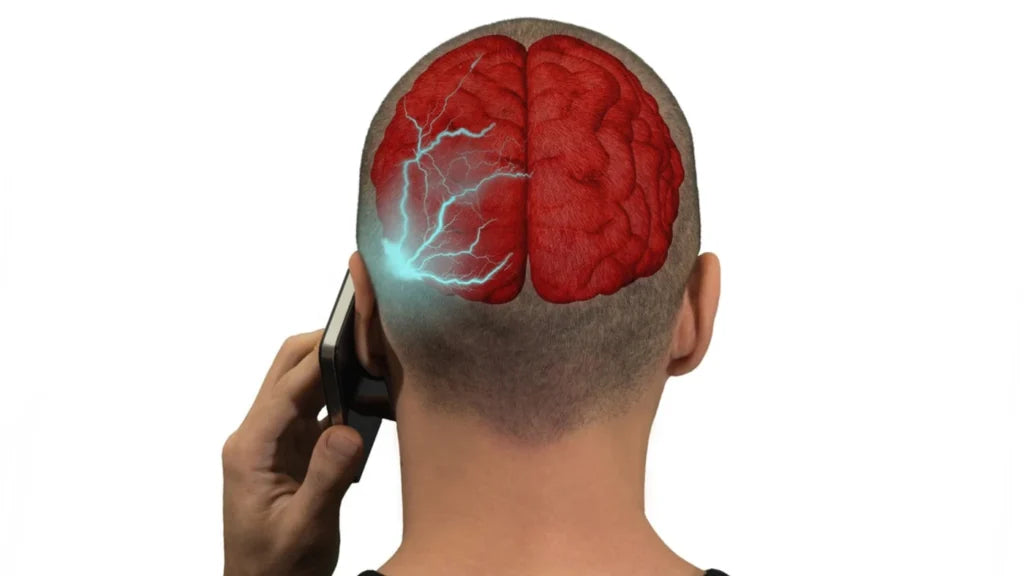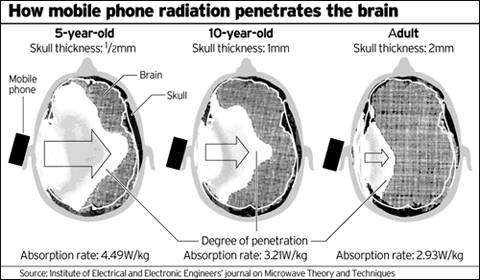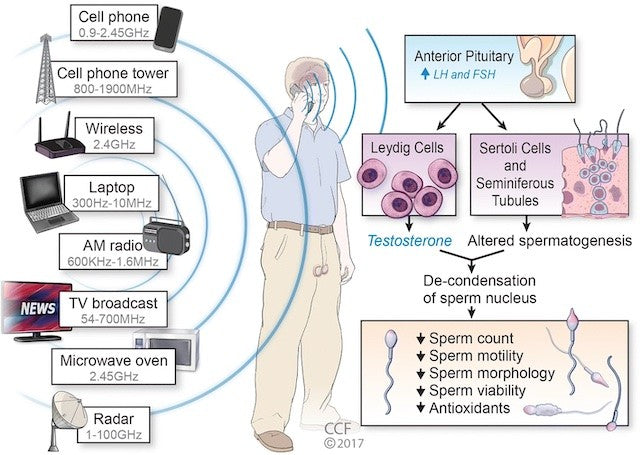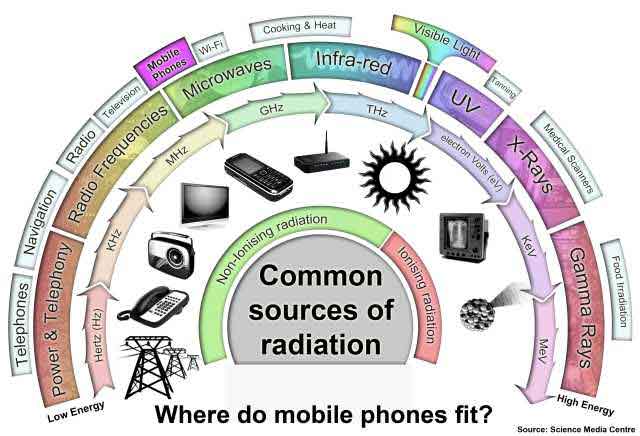Table of Contents
Electromagnetic fields (EMF) are increasingly becoming a regular part of life in the modern world. Our smartphones, smart watches, AirPods, and all wireless smart-home features, including even our Wi-Fi routers are constantly producing radiation. While these EMFs may not be ionizing radiation which poses a direct and obvious threat of DNA damage and cancer production, many are concerned about more subliminal effects that these technologies may be exposing us to.
People are growing particularly concerned with EMFs regarding the apparent testosterone epidemic that men are experiencing worldwide. Recent studies have confirmed some sort of link between cell phones and other EMF sources to the decline in testosterone. Many people fear that our technology may be a driving factor in this epidemic.
It is undeniable that low serum testosterone is becoming increasingly common. In this post, we will explore the relationship between EMFs and testosterone levels in the modern world.
Understanding EMF Radiation
Electromagnetic radiation (EMR) refers to the energy that electromagnetic waves carry as they travel through space.
These waves are generated by the movement of charged particles, like electrons. EMR encompasses a broad spectrum, including both ionizing and non-ionizing radiation. Ionizing radiation, with higher frequencies like X-rays and gamma rays, possesses enough energy to strip electrons from atoms, with the capacity to cause direct cellular damage.
Non-ionizing radiation, on the other hand, includes lower-frequency types such as radio waves, microwaves, and extremely low-frequency fields, like those from power lines. Devices such as cell phones, Wi-Fi routers, and electronic appliances emit these lower-frequency EMFs. Non-ionizing radiation has often been dismissed as “less harmful” but concerns remain about society’s development into prolonged and ubiquitous EMR exposure from a growing number of sources.

Understanding the multitude of sources and the difference between these types of EMF radiation is crucial for evaluating potential health impacts and implementing measures to reduce excessive exposure in our high-tech world.
Sources of Constant EMF Exposure
Sources of EMF are many, but the most significant sources are radio wave frequencies from Wi-Fi, Bluetooth, and cellular signals (currently mostly 4G and more recently 5G). This is an inevitable factor due to how deeply we’ve implemented wireless technologies into our homes and lives.
Smartphones, smartwatches, computers, etc. are all producing EMR as they communicate with each other and the grid of the internet and cellular networks which provide entertainment and information to the masses. Even our cars, particularly electric cars, increasingly emit radiation in significant amounts.
EMF Penetrating the Human Body
Electromagnetic fields consist of waves of energy that can and do penetrate the human body.

When exposed to EMF, the electromagnetic waves interact with biological tissues by creating electric currents and molecular movements. These waves can penetrate through our multiple layers of skin and reach our internal organs as they travel through tissues with varying absorption levels.
The extent of penetration depends on the frequency and intensity of the EMF, with higher frequencies having the potential to reach deeper into the body. Once inside, these electromagnetic waves can influence various cellular functions, potentially disrupting the delicate balance of the endocrine (hormonal) system and affecting the normal physiological processes within organs and tissues.
More Resources on the Effects of EMF on Biological Functions
- EMF and Health – Annual Review of Public Health
- A Study on the Biological Effects of Exposure Mobile-phone Frequency EMF
- Possible Effects of Electromagnetic Fields (EMF) on Human Health—Opinion of the Scientific Committee on Emerging and Newly Identified Health Risks (SCENIHR)
Testosterone and its Crucial Role
Testosterone is a key hormone that is primarily associated with male development. It plays a pivotal role in various physiological and psychological functions.
Beyond its well-known impact on muscle mass and bone density, testosterone influences energy levels, mood regulation, and the maintenance of reproductive tissues. Additionally, testosterone contributes to the development of secondary sexual characteristics, including facial and body hair, the deepening of the voice, and the growth of the Adam’s apple. Its significance extends beyond reproductive years, affecting overall health and well-being throughout a man’s life.
Many of these regulatory functions such as muscle mass, fertility, and psychological regulation also apply to women. It is a little-known fact that adult women typically have more testosterone than they do estrogen, and similarly need adequate testosterone levels to feel and perform at their best.
Testosterone is a key hormone for all human beings and should not be oversimplified to its common associations with muscle building and masculinity exclusively.
Factors Influencing Testosterone Levels
Various factors contribute to regulating testosterone levels, including age, genetics, lifestyle, and environmental influences.
Hormonal balance is delicate, and disruptions in this equilibrium can have profound implications for all people’s health, particularly on male and female fertility. Given the multifaceted nature of testosterone’s functions, any external factor capable of influencing its levels understandably raises concerns about potential health consequences.
Even subtle shifts in testosterone levels can have a life-changing impact on an individual’s overall health, emphasizing the need for a comprehensive understanding of the factors that may contribute to hormonal imbalances, including the potential impact of EMF.
Research Findings on EMF and Testosterone
Over the past decade, a growing body of research has explored the association between EMF exposure and alterations in hormonal levels, including testosterone.
Numerous studies have investigated the impact of prolonged exposure to electromagnetic fields on the endocrine system, revealing varying degrees of correlation between EMF and hormonal changes, and even potential causality.
Asian Pacific Journal of Reproduction
Findings in the study:
- Long-term exposure to low-frequency EMF decreased the diameter of the seminiferous tubules and also, increased the number of seminiferous (producing or conveying semen) tubules per unit area of testis
- Cell phone waves decreased sperm parameters in human semen samples.
- Radiofrequency electromagnetic wave exposure from cell phones adversely affects the male fertilizing potential of spermatozoa (mature male motile sex cells).
- Long-term exposure to low-frequency electromagnetic fields decreased testosterone levels.
- Concluded that long-term low-frequency EMF exposure may lead to structural and functional changes in the male testes and may impair male fertility
Effects of Mobile Phone Radiation on Serum Testosterone
Findings in the study:
- Long-term exposure to mobile phone radiation led to a reduction in serum testosterone levels
- Though this was an animal study done on Wistar Albino rats, based on this study such effects are also expected in humans. This suggests that chronic and excessive use of mobile phones should be avoided wherever possible to protect male fertility and hormonal health
1950MHz Radio Frequency Electromagnetic Radiation Inhibits Testosterone Secretion of Mouse Leydig Cells
Findings from the study:
- Electromagnetic radiation elicited inhibition of the proliferation and changes in cell cycle distribution, and the dysfunction of testosterone secretion in TM3 (Leydig TM3 cells – major testosterone-producing cells of the male reproductive system) cells after exposure to 24-hour continuous 1950 MHz GSM-Talk radiation.
- These effects were not induced by increasing intracellular ROS levels and did not cause TM3 cell apoptosis.
- This led the researchers to hypothesize that inhibition of TM3 cell proliferation in this study stemmed from changes in cell cycle distribution and led to the dysfunction of testosterone secretion in TM3 cells.

Effects of 1800-MHz Radiofrequency Fields on Circadian Rhythm of Plasma Melatonin and Testosterone in Male Rats
Findings from the study:
- The study confirmed that circadian rhythms and melatonin and testosterone are indeed related and have an inverse relationship in peak phases of these rhythms.
- Circadian rhythms were disturbed after exposure to radio frequencies of 1800-MHz.
- The exposure had an even greater effect on melatonin.
- Data suggest that regulation of testosterone is controlled and influenced by melatonin, and that melatonin is sensitive to radiofrequency exposure.
These studies all point to the reduction of EMF exposure as something that can indeed mitigate the reduction of testosterone and impairment of male fertility. Even studies that don’t directly suggest a reduction of EMF do call for the need for further research in this rapidly evolving landscape.
At Aires Tech we strive to add our voice to the call so that we can further our understanding of the effects of these technologies on our hormones and ultimately our lives and our family members’.
Potential Mechanisms of EMF-induced Testosterone Disruption
The potential mechanisms through which EMF may reduce testosterone can be essentially summed up as stress in the body and disruptions in normative biological functions. This stress and disruption is due to EMFs’ and EMR’s ability to induce oxidative stress and disrupt the blood-testis barrier, both of which play a crucial role in maintaining the testes’ microenvironment.
Additionally, studies have proposed that EMF exposure may influence the hypothalamic-pituitary-gonadal (HPG) axis, a key regulatory system governing testosterone synthesis.
The specific pathways through which EMF exerts these effects remain an active area of investigation, but the existing body of research suggests a plausible link between prolonged EMF exposure and diminished testosterone levels, emphasizing the need for further exploration and a cautious approach toward managing EMF exposure in daily life.
Real-world Scenarios and EMF Exposure
Everyday scenarios expose individuals to varying degrees of electromagnetic fields incredibly consistently.
Consider the prevalence of electronic devices such as laptops, smartphones, and Wi-Fi-enabled tech in daily life. These devices emit EMF and therefore are increasingly exposing people to electromagnetic radiation as we further the integration of these technologies into our work and home lives.

The most simple example of this is that most men carry their phones in their pockets throughout the majority of their days and, over time the majority of their lives. This means that most men are constantly placing a source of electromagnetic radiation directly next to their testes, which is where their testosterone is produced, or in some cases… not produced.
This exposure is not limited to cell phones though. The average workplace often introduces additional sources of EMF, as offices and industrial settings are filled with electronic machinery and communication systems. Computers, printers, fax machines, Bluetooth-connected office features… the list goes on and continues to grow each year as we develop new technological solutions that are optimized for short-term convenience, but unfortunately not optimized for human health.
Mitigation Strategies
Practical steps can be taken to reduce daily exposure to EMF and mitigate potential negative impacts on testosterone levels and male reproductive health.

- First and foremost, opting to not carry one’s cell phone directly next to their genitals is of incredibly key importance. These organs are extremely sensitive for obvious reasons, and proximity is a major factor in the influence of electromagnetic radiation.
- Even if having a phone in your pocket is necessary at times, you can switch it to airplane mode which will turn off the radio wave signaling and receiving capacity of your phone, thereby greatly reducing testes’ direct exposure to EMR.
- Developing simple habits such as using speakerphone or wired earphones during phone calls will minimize direct contact with devices emitting EMF.
- Creating dedicated spaces within living and sleeping areas that are free from electronic devices can offer periods of reduced exposure, especially during crucial resting hours.
- Utilizing wired internet connections instead of relying solely on Wi-Fi, and keeping electronic devices at a distance when not in use can do a lot to reduce the daily load of EMR.

- Implementing protective measures, such as using EMF-modulating devices, like the patented products produced by Aires Tech, can further reduce personal exposure in environments with high electronic device usage.
- Even more basic lifestyle shifts, such as regular breaks from electronic devices and spending more time outdoors, can contribute to a holistic approach to minimizing the potential adverse effects of prolonged EMF exposure on testosterone levels and male reproductive health.
Final Conclusion on EMF and Testosterone
In conclusion, the potential impact of EMF exposure on testosterone levels and male reproductive health remains a subject of both intrigue and concern.
A growing body of research suggests an association between prolonged EMF exposure and hormonal changes, including a significant decline in testosterone. The existing body of literature exhibits varying findings and methodological intricacies, emphasizing the need for further well-designed studies to draw definitive conclusions.
As we navigate an increasingly technology-centric era, understanding the real-world scenarios contributing to high EMF exposure and implementing practical mitigation strategies becomes imperative. By incorporating lifestyle changes, and protective measures, and fostering awareness, individuals can strive to strike a balance between the convenience of modern technology and the potential health implications associated with excessive EMF exposure.
We at Aires Tech strive to continue to offer research and innovate in the EMF protection space. We hope to help you, the reader, to build a healthier relationship with the amazing new technologies of the modern world, and we thank you for joining us in this venture.
Related Posts
- EMF and Male Fertility: New Sperm Health Study
- Testosterone & EMFs: What the Experts say
- Deep Dive on Male Fertility + EMF
- Hidden Threat of EMFs on Male Fertility
- Exploring EMF Research: Nervous System, Reproduction + Brain Function

